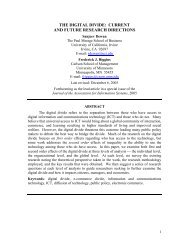Agent-Based Modeling to Inform Online Community Theory and ...
Agent-Based Modeling to Inform Online Community Theory and ...
Agent-Based Modeling to Inform Online Community Theory and ...
You also want an ePaper? Increase the reach of your titles
YUMPU automatically turns print PDFs into web optimized ePapers that Google loves.
munity activity, <strong>and</strong> the average number of login sessions per member, which is an indica<strong>to</strong>r of<br />
member commitment. We also examined the benefits members received from being part of the<br />
community, often invisible <strong>to</strong> community managers. We ran two two-way ANOVA analyses <strong>to</strong> ex-<br />
amine the main effects of moderation <strong>and</strong> its interactions with <strong>to</strong>pical breadth <strong>and</strong> message volume.<br />
We also examined the benefits members received at the 100 th , 150 th , 200 th , 250 th <strong>and</strong> 300 th day of<br />
the experiment, a <strong>to</strong>tal of five snapshots. We analyzed information access benefits <strong>and</strong> bonds bene-<br />
fits that our simulation results revealed as media<strong>to</strong>rs, <strong>to</strong> underst<strong>and</strong> the link between experimental<br />
conditions <strong>and</strong> community outcome measures.<br />
3.2. Results<br />
3.2.1. Effects of Moderation on <strong>Community</strong> Activity. Analyses of the impact of moderation<br />
on community activity (posts per day) in communities differing in <strong>to</strong>pical breadth revealed a significant<br />
main effect of moderation. As shown in Figure 4, personalized moderation led <strong>to</strong> the highest level of<br />
community activity (15 <strong>to</strong> 20 posts per day), about 50% more than community-level moderation <strong>and</strong> 36%<br />
more than no moderation (p < .001). There was no significant difference between community-level mod-<br />
eration <strong>and</strong> no moderation (p = .24). The analyses also revealed a significant interaction between modera-<br />
tion <strong>and</strong> <strong>to</strong>pical breadth (p = .05). Personalized moderation led <strong>to</strong> 67% more posts than community-level<br />
moderation <strong>and</strong> no moderation in communities with moderate (five <strong>to</strong>pics) <strong>and</strong> high <strong>to</strong>pical breadth (nine<br />
<strong>to</strong>pics), compared <strong>to</strong> 0% <strong>to</strong> 25% more posts in communities with a single nominal <strong>to</strong>pic. Topical breadth<br />
by itself had no effect on community activity (p = .65).<br />
Insert Figure 4 about Here<br />
Analyses of the impact of moderation on community activity in communities differing in message<br />
volume revealed two main effects <strong>and</strong> a significant interaction between moderation <strong>and</strong> message<br />
volume, as shown in Figure 5. By definition, communities with high message volume had more<br />
posts per day than communities with low volume (20 messages versus 10 messages, p < .001). Per-<br />
sonalized moderation, again, led <strong>to</strong> more posts than community-level moderation <strong>and</strong> no moderation<br />
(p < .001). The interaction effect indicates that the difference was much greater in communities with<br />
22
















